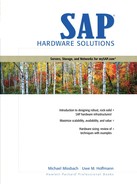Chapter 3. Sizing Systems for mySAP.com The Science of Estimation
An important aspect to successfully implementing an SAP project is to cost effectively predict the system's configuration. This is considered the sizing process, which consists of two distinct elements: (1) estimating the business processing aspects, and (2) determining the hardware configuration to handle the estimated requirements.
Unfortunately sizing is not an exact science. The more accurate the input to the sizing process, the greater the accuracy of the overall result and thus the configuration will be. Sizing is not a one-time job but an iterative process. Time invested in reevaluating the sizing is time well spent.
There are many reasons for requiring a sizing. At the beginning of an SAP implementation project, the sizing estimate is most often used for budget purposes. The IT manager responsible for the SAP project wants to know if the implementation is feasible given the available project data. Although the data collected at the beginning is very rough, making an accurate sizing difficult, it is usually possible to provide an order of magnitude estimation of the hardware requirements. This is an important element to help ground and orient the implementation project team.
Ideally, a proposal may be made early on for a development system, which requires little in terms of sizing analysis. As the SAP project matures, the business processes being implemented become known and more accurate sizings become possible. Sizing proposals for the first production phase can be made with analysis of the document or transaction volumes. More sizings can be made in an iterative process as the project matures and as the production start date nears with the final hardware requirements. The infrastructure requirements are also proposed in detail at this point.
Once the project has gone into production, release changes or additional users cause the system requirements to increase. This is considered upgrade or resizing. The methodology for sizing a running system with known transaction volumes is different than when sizing a system before it is implemented (with only estimates).
The hardware resources needed to handle the sizing requirements are SAP software and release dependent. Each hardware vendor is responsible for estimating its server's capacity for each of these software versions or releases. Some differences may exist in the way these capacities or transaction-processing capabilities are expressed because each hardware vendor wants to win the business. Often only the minimum hardware requirements are suggested in order to keep the costs low, which quickly leads to a hardware upgrade demand.
